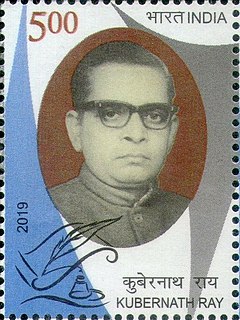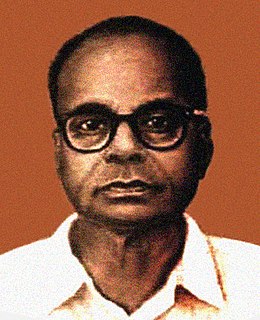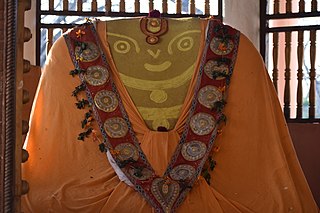
Dr. K. Ayyappa Paniker, sometimes spelt "Ayyappa Panicker", was an influential Malayalam poet, literary critic, and an academic and a scholar in modern and post-modern literary theories as well as ancient Indian aesthetics and literary traditions. He was one of the pioneers of modernism in Malayalam poetry, where his seminal works like Kurukshethram (1960), considered a turning point in Malayalam poetry, Ayyappapanikkarude Krithikal and Chintha and several essays were an important influence on the playwrights of his generation.
Ponna (c. 945) was a noted Kannada poet in the court of Rashtrakuta Dynasty king Krishna III (r.939–968 CE). The emperor honoured Ponna with the title "emperor among poets" (Kavichakravarthi) for his domination of the Kannada literary circles of the time, and the title "imperial poet of two languages" for his command over Sanskrit as well. Ponna is often considered one among the "three gems of Kannada literature" for ushering it in full panoply. According to the scholar R. Narasimhacharya, Ponna is known to have claimed superiority over all the poets of the time. According to scholars Nilakanta Shastri and E.P. Rice, Ponna belonged to Vengibisaya in Kammanadu,Andhra Pradesh, but later migrated to Manyakheta, the Rashtrakuta capital, after his conversion to the Jainism.
Nannūl is a work on Tamil grammar written by a Jain ascetic Pavananthi Munivar around 13th century CE. It is the most significant work on Tamil grammar after Tolkāppiyam. The work credits Western Ganga vassal king Seeya Gangan of Kolar with patronising it.
Rudrabhatta was an influential 12th-century Kannada poet in the court of the Hoysala Empire King Veera Ballala II(r.1173–1220 CE). According to Kannada language expert Narasimhacharya, the poet was also patronized by a minister of the King. The literary critic Mukherjee feels that after a century of literary revolution caused by the Veerashaiva poets, a benevolent atmosphere created by the king may have encouraged this Vaishnava writer and poet.

Vellithuruthi Thazhathu Karutha Patteri Raman Bhattathiripad (1896–1982), popularly known as V. T. Bhattathiripad or simply V. T., was an Indian social reformer, dramatist and an Indian independence activist. He was best known for his contributions in the reformation of the casteism and conservatism that existed in the Namboothiri community. He wrote a number of books which include a play, Adukkalayail Ninnu Arangathekku and his autobiography, Kanneerum Kinavum and many critics consider them as notable works in Malayalam literature. Kerala Sahitya Akademi honoured him with distinguished fellowship in 1976.
Nijaguna Shivayogi was an Indian poet and a prolific writer in the Kannada language. He lived in the 15th century. He was a follower of the Veerashaiva faith, which he attempted to reconcile with the Advaita Hinduism of Adi Shankaracharya. Tradition has it that Shivayogi was a petty chieftain of Kollegal taluk in modern Mysore district of Karnataka state, India. Considered a visionary of his time, his Vivekachintamani, written in encyclopaedic proportions and in prose style, and the Kaivalya Paddhati, a musical treatise consisting of songs are considered his most enduring works.

Kuber Nath Rai, also written as Kubernath Ray and Kuber Nath Ray, was a writer and scholar of Hindi literature and Sanskrit.
Vennikkulam Gopala Kurup (1902–1980) was an Indian poet, playwright, translator, lexicographer and story writer of Malayalam. He was the author of a number of poetry anthologies, besides other works, and he translated Abhijnana Shakuntalam, Tulsi Ramayana, Tirukkuṛaḷ, the poems of Subramania Bharati and two cantos of The Light of Asia of Edwin Arnold into Malayalam. He also contributed in the preparation of a dictionary, Kairali Kosham. A recipient of the Odakkuzhal Award and Thirukural Award, Kurup received the Kerala Sahitya Akademi Award for Poetry in 1966. Sahitya Akademi honoured him with their annual award in 1974.
Bodheswaran, , was an Indian independence activist, social reformer and a poet of Malayalam literature. He was known for his nationalistic poems such as Keralaganam and for his involvement in social movements like Vaikom Satyagraha and other related events which led to the Temple Entry Proclamation of 1936.
Swami Anand was a monk, a Gandhian activist and a Gujarati writer from India. He is remembered as the manager of Gandhi's publications such as Navajivan and Young India and for having inspired Gandhi to pen his autobiography, The Story of My Experiments with Truth. He wrote sketches, memoir, biographies, philosophy, travelogues and translated some works.
Sankari Prasad Basu was an Indian scholar, writer and critic who writes mainly in the Bengali language. He is a researcher on Swami Vivekananda and his books on the subject include Sahashya Vivekananda and Bandhu Vivekananda. One of his notable publications is his seven-volume research work Vivekananda o Samakalin Bharatbarsha, for which he won the prestigious Sahitya Akademi Award in 1978.
Kadhirur Gurukkal, also known as Mathiloor Gurukkal, was a martial artist of medieval India. He came from Kadirur, near to Thalasserry in the North Malabar region of present-day Kerala. He operated the Mathiloor Kalari, where Thacholi Othenan trained in Kalaripayattu.
R. Narayana Panickar was an Indian essayist, playwright, translator, lexicographer, novelist and historian of Malayalam. He was credited with over 100 books but the best known among them are the six-volume work, Kerala Bhasha Sahithya Charthram, a comprehensive history of Malayalam literature up to 1954 and Navayuga Bhasha Nighantu, a lexicon. He also wrote a number of novels and translated several classics of Tamil literature including Purananuru, Akanaṉūṟu and Silappatikaram. Sahitya Akademi honoured him with their annual award in 1955.

Kuttipuzha Krishna Pillai, was an Indian scholar, journalist, philosopher, atheist and critic of Malayalam language. Counted among the prominent literary critics of the language, he wrote a number of books covering the genres of literary criticism and philosophy. He presided over the Kerala Sahitya Akademi, chaired the advisory board of the Kerala Bhasha Institute as an ex-officio member and was a recipient of the Soviet Land Nehru Award.

Balarama Dasa was an Odia poet and litterateur. He was one of the 5 great poets in Odia literature, the Panchasakha during the Bhakti age of literature. He was the eldest of the Pancha sakha. He wrote the Jagamohana Ramayana also known as Dandi Ramayana.

Jasobanta Dasa was an Odia poet, litterateur and mystic. He was one of the five great poets in Odia literature, the Panchasakha during the Bhakti age of literature. He is known for his work Prema Bhakti Brahma Gita.
The Varna Ratnakara, Maithili: वर्ण रत्नाकर,, literally "Ocean of description", is the oldest prose work of Maithili language, written in 1324 CE by the Maithil scholar, priest and poet Jyotirishwar Thakur. The author was a part of the court of King Harisimhadeva of the Karnat dynasty whose capitals were in both Simraungadh and Darbhanga.
Chautisa or Chautisha is a genre of literary composition in Indian literature. It was popular form of writing in medieval poetry. It is a form of constrained writing where each verse begins with consecutive letters of the alphabet, typically starting with the first consonant. The word 'Chautisa' means thirty four, signifying the number of consonants in Odia script.





